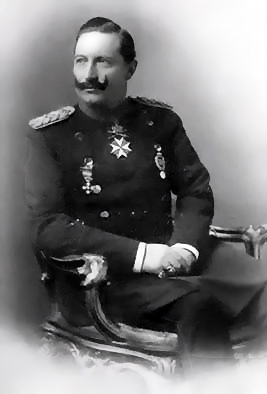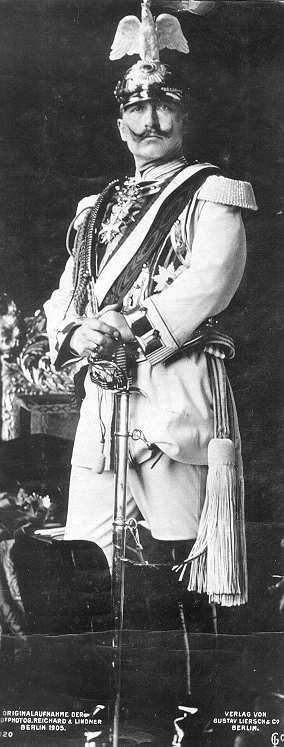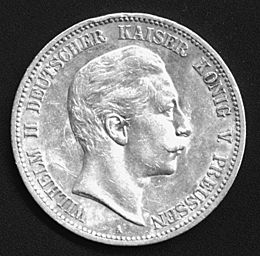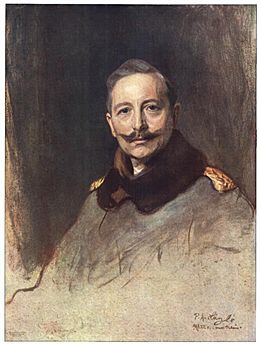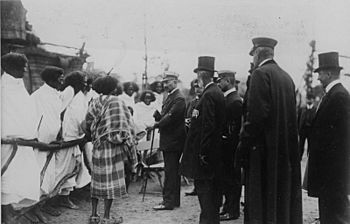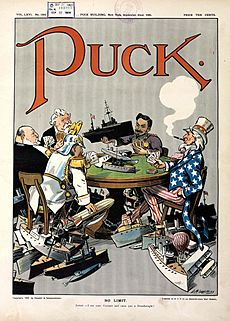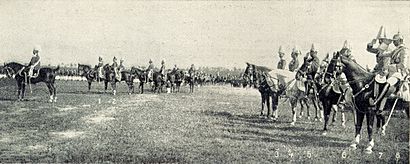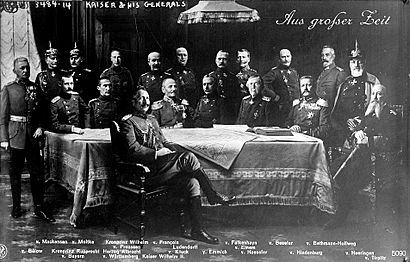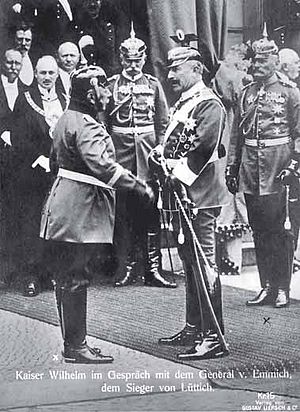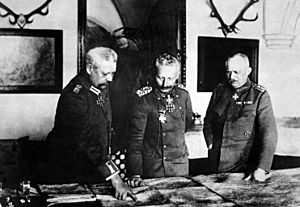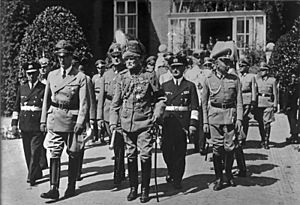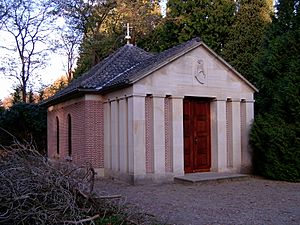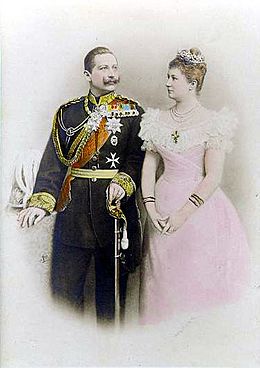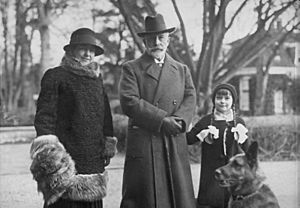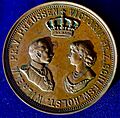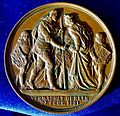Wilhelm II, German Emperor facts for kids
Quick facts for kids Wilhelm II |
|||||
|---|---|---|---|---|---|
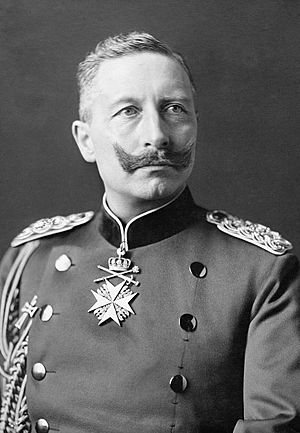
Portrait by T. H. Voigt, 1902
|
|||||
| German Emperor King of Prussia |
|||||
| Reign | 15 June 1888 – 9 November 1918 | ||||
| Predecessor | Frederick III | ||||
| Successor | Monarchy abolished | ||||
| Chancellors | |||||
| Born | Prince Friedrich Wilhelm of Prussia 27 January 1859 Kronprinzenpalais, Berlin, Kingdom of Prussia |
||||
| Died | 4 June 1941 (aged 82) Huis Doorn, Doorn, Netherlands |
||||
| Burial | 9 June 1941 Huis Doorn, Doorn |
||||
| Spouse |
|
||||
| Issue |
|
||||
|
|||||
| House | Hohenzollern | ||||
| Father | Frederick III, German Emperor | ||||
| Mother | Victoria, Princess Royal | ||||
| Religion | Lutheranism (Prussian United) | ||||
| Signature |  |
||||
Wilhelm II (born Friedrich Wilhelm Viktor Albert; 27 January 1859 – 4 June 1941) was the last German Emperor (or Kaiser) and King of Prussia. He ruled from 1888 until he gave up his power in 1918. He was a member of the House of Hohenzollern, a powerful royal family.
Wilhelm II wanted to make the German Empire a very strong country. He built a large navy, but his actions and words often upset other nations. Many historians believe his policies helped cause World War I. After Germany lost the war in 1918, Wilhelm was forced to step down. This ended the German Empire and the Hohenzollern family's long rule.
Wilhelm was the son of Prince Frederick William and Victoria, Princess Royal. His mother was the oldest grandchild of Queen Victoria of the United Kingdom. In 1888, his father became Emperor Frederick III but died just 99 days later. Then, Wilhelm became Emperor Wilhelm II.
After becoming emperor, Wilhelm removed Chancellor Otto von Bismarck from power in 1890. Wilhelm then took direct control of Germany's policies. He wanted Germany to be a leading world power. During his rule, Germany gained new lands in China and the Pacific. It also became Europe's largest manufacturer. However, Wilhelm often upset other countries with his strong statements. His government also built a huge navy, which worried Britain. By the early 1900s, Germany had few strong allies, mostly Austria-Hungary and the Ottoman Empire.
Wilhelm's rule ended with Germany supporting Austria-Hungary in July 1914. This was a key event that led to World War I. During the war, Wilhelm let the German Army make most of the big decisions. By 1916, the army was largely in charge of the country. Germany won against Russia, but lost badly on the Western Front in 1918. Wilhelm lost the support of his army and his people. He was forced to give up his throne during the German Revolution of 1918–1919. Germany then became a democratic country called the Weimar Republic. Wilhelm went to live in the Netherlands, where he died in 1941.
Contents
Wilhelm II: Germany's Last Emperor
Early Life and Family
Wilhelm was born in Berlin on 27 January 1859. His mother was Victoria, Princess Royal, the oldest daughter of Britain's Queen Victoria. His father was Prince Frederick William of Prussia. At his birth, his great-uncle, Frederick William IV of Prussia, was King of Prussia.
Wilhelm was the first son of the Crown Prince of Prussia. When his great-uncle died in 1861, Wilhelm's grandfather became King. This made two-year-old Wilhelm second in line to the Prussian throne. After 1871, he was also second in line to the new German Empire.
A Difficult Childhood
Wilhelm had a difficult birth. This caused a problem with his left arm, making it shorter than his right. This condition is called Erb's palsy. He often tried to hide his arm in photos. Historians believe this physical challenge affected how he grew up.
When he was four, Wilhelm visited England for a royal wedding. He was a lively child. His uncle, Prince Alfred, tried to quiet him, but Wilhelm bit him! His grandmother, Queen Victoria, still thought he was a "clever, dear, good little child."
His mother was very worried about his arm. She wanted him to be a good rider, which was important for a future king. Riding lessons were very hard for Wilhelm, but he eventually learned to balance on a horse.
From age six, Wilhelm was taught by a teacher named Georg Ernst Hinzpeter. Wilhelm later wrote that Hinzpeter was a good teacher, but the riding lessons were "torments" caused by his mother.
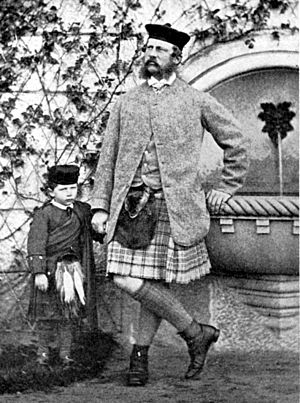
Education and Military Training
As a teenager, Wilhelm went to school in Kassel. In 1877, he finished high school and received the Order of the Garter from Queen Victoria. He then studied law and politics at the University of Bonn. Wilhelm was smart but could be quick-tempered.
Being part of the royal House of Hohenzollern, Wilhelm grew up around military life. This greatly influenced him. As an adult, he was almost always seen in a military uniform. The strong military culture of Prussia shaped his ideas and relationships.
Wilhelm looked up to his father, who was a hero from the wars that united Germany. However, he later felt mixed emotions about his father. He thought his mother had too much influence over him. Wilhelm also admired his grandfather, Wilhelm I.
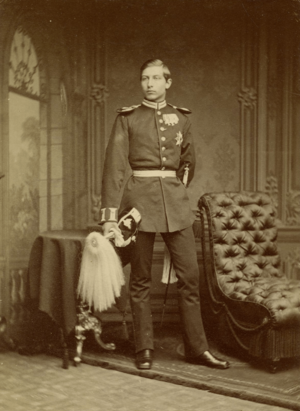
Wilhelm did not like his parents' attempts to teach him British liberal ideas. Instead, he preferred the idea of a strong, single ruler. He became very "Prussianized" and felt distant from his parents. He suspected them of putting Britain's interests first.
When Wilhelm was about 21, his grandfather, Emperor Wilhelm I, decided it was time for him to start his military training. He became a lieutenant in the First Regiment of Foot Guards in Potsdam. Wilhelm felt like he found his "family" and "friends" in the Guards. He changed from a polite student to a more direct, military-style officer.
Family Life
When Wilhelm was in his early twenties, Chancellor Otto von Bismarck tried to separate him from his parents. Bismarck wanted to use the young prince against his parents to keep his own power. This led to a difficult relationship between Wilhelm and his parents, especially his English mother.
In 1880, Wilhelm got engaged to Augusta Victoria of Schleswig-Holstein, known as "Dona." They married in 1881 and were together for 40 years. They had seven children: six sons and one daughter.
Becoming Emperor
Emperor Wilhelm I died on 9 March 1888. Wilhelm's father became Emperor Frederick III. However, Frederick was already very sick with throat cancer and died just 99 days later. On 15 June of that same year, his 29-year-old son, Wilhelm, became the German Emperor and King of Prussia.
As a young man, Wilhelm had admired Otto von Bismarck, the powerful Chancellor who helped create the German Empire. But Wilhelm was impatient and soon disagreed with Bismarck's careful foreign policy. Wilhelm wanted Germany to expand quickly and become a world power.
Unlike his grandfather, Wilhelm wanted to rule as well as reign. Emperor Wilhelm I had let Bismarck handle daily government tasks. But Wilhelm II wanted to be in charge. This led to early conflicts between the new Emperor and his Chancellor. Bismarck thought Wilhelm was easy to control and didn't respect his ideas. Their final disagreement happened in 1890 over a law against Socialists.
Rift with Bismarck
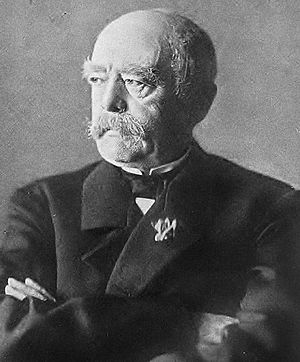
Wilhelm wanted to be more involved in social issues, especially helping mine workers who went on strike in 1889. He often argued with Bismarck about social policy. Bismarck disagreed with Wilhelm's pro-worker ideas and tried to work around them. Bismarck felt pressured and unappreciated by the young Emperor.
The final break happened when Bismarck tried to form a new government group. He started talking with the Catholic Centre Party. The Kaiser was very angry because he was not told about these talks beforehand.
After a heated argument, Wilhelm left Bismarck's home. Bismarck then wrote a strong letter of resignation. In it, he criticized Wilhelm's involvement in both foreign and domestic policy. This letter was published only after Bismarck's death.
On 6 May 1890, the Kaiser announced that the most important issue was to improve laws protecting workers. In 1891, the government passed the Workers Protection Acts, which made working conditions better and protected women and children.
Wilhelm in Control
Bismarck's Dismissal
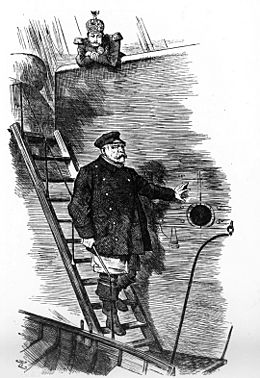
Bismarck resigned in 1890 at Wilhelm II's request. He was 75 years old. New Chancellors were appointed, but Wilhelm wanted to have the main say in how the empire was run. These new Chancellors were government officials, not powerful politicians like Bismarck. Wilhelm did not want another strong Chancellor who would control everything.
After Bismarck left, Russia became closer to France. This eventually led to Germany being largely isolated by 1914. Some historians believe that Bismarck's removal led Germany down a dangerous path towards World War I. Others argue that Bismarck's time was over and that he had divided the German people.
In the early 1900s, Wilhelm focused on building a German Navy that could compete with Britain's. He wanted Germany to be a world power. He ordered his military leaders to read books about sea power and even drew sketches of ships. His Chancellors handled domestic issues, while Wilhelm's strong opinions on foreign affairs worried other European leaders.
Supporting Arts and Sciences
Wilhelm was a big supporter of the arts and sciences, as well as education and social welfare. He helped create the Kaiser Wilhelm Society to promote scientific research. This group was funded by rich donors and the state. He also supported changes to the Prussian education system, which was very old-fashioned.
Wilhelm also encouraged the Order of Saint John to improve German medicine. This order ran hospitals, nursing schools, and nursing homes across the German Empire.
Wilhelm's Personality
Historians often talk about how Wilhelm's personality shaped his rule. He was known for being unstable and often hid his deep insecurities with strong words. He could also become depressed or very emotional. These traits in Germany's leader caused unease in Europe.
Wilhelm had a complicated relationship with Britain. He was half-German and half-English. He wanted to be accepted by the British, but also felt jealous and resented them.
Relationships with Royal Relatives
Wilhelm was Queen Victoria's grandchild, making him a cousin to many European royals. These included King George V of the United Kingdom and Nicholas II of Russia.
His relationships with his British relatives were often difficult. He wanted his grandmother Queen Victoria's approval. While she was kind to him, other relatives often did not accept him. He had a particularly bad relationship with his uncle, Edward VII, who was the Prince of Wales. Wilhelm felt his uncle treated him like a nephew, not a reigning monarch.
Despite their difficult relationship, Wilhelm traveled to England when Queen Victoria was dying in 1901. He was by her side when she passed away and stayed for her funeral. He also attended King Edward VII's funeral in 1910.
In 1913, Wilhelm hosted a grand wedding in Berlin for his only daughter, Princess Victoria Louise of Prussia. His cousins Tsar Nicholas II and King George V were among the guests.
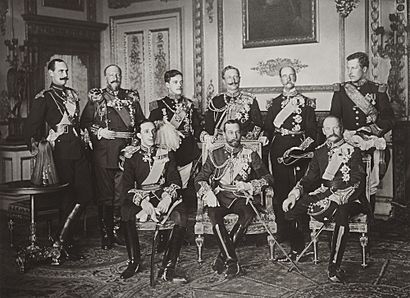
Foreign Affairs
Wilhelm II's foreign policy faced many challenges. He was impatient and often made decisions based on his feelings. For example, in 1896, he sent a telegram to President Paul Kruger of the Transvaal Republic, congratulating him for stopping the British. This angered Britain.
British public opinion, which had been positive towards the Kaiser, turned negative in the late 1890s. During World War I, he became a main target of British propaganda.
Wilhelm also tried to warn other European leaders about a "yellow peril" from Asia, but few paid attention. Germany invested in its colonies in Africa and the Pacific, but most were not profitable and were lost during World War I. In German South West Africa, a revolt led to a terrible event known as the Herero and Namaqua genocide, which Wilhelm eventually ordered to stop.
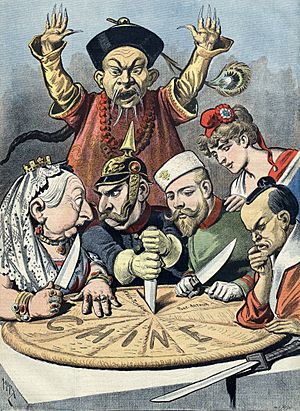
Visits to the Ottoman Empire
Wilhelm visited Istanbul in 1889 and helped sell German rifles to the Ottoman Army. He made a second important visit to the Ottoman Empire in 1898. He traveled to Istanbul, Haifa, Jerusalem, Bethlehem, and Damascus. During this trip, Wilhelm secured a promise for German companies to build the Berlin–Baghdad railway. He also had the German Fountain built in Istanbul to remember his visit.
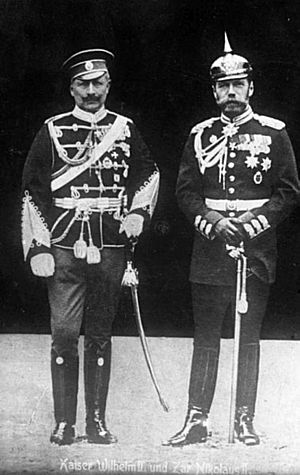
The "Hun Speech"
In 1900, during the Boxer Rebellion in China, Wilhelm gave a famous speech to German soldiers. He told them to be as merciless as the Huns. This speech showed his strong vision for Germany as a great power. The term "Hun" later became a negative nickname for Germans during World War I.
Moroccan Crisis
One of Wilhelm's diplomatic mistakes led to the First Moroccan Crisis in 1905. He visited Tangier, Morocco, and declared his support for the Sultan's independence. This was a direct challenge to France, which wanted more control in Morocco. This event led to the Algeciras Conference, which further isolated Germany in Europe.
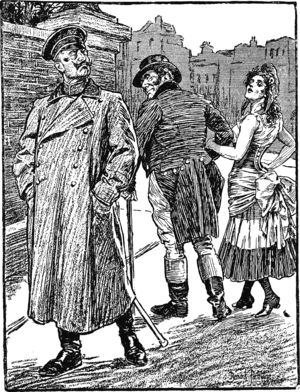
Daily Telegraph Affair
In 1908, an interview with Wilhelm was published in a British newspaper, The Daily Telegraph. In it, Wilhelm made many wild and damaging statements. He wanted to promote friendship between Britain and Germany, but his emotional outbursts had the opposite effect. He suggested that Germans didn't care for the British, and that France and Russia tried to get Germany to join a war against Britain. He also said the German navy was for Japan, not Britain. He famously said, "You English are mad, mad, mad as March hares."
This caused a huge stir in Germany, with some people even calling for him to step down. Wilhelm kept a low profile for months and later forced his Chancellor to resign. This crisis deeply hurt Wilhelm's confidence, and he never fully recovered. He lost much of his power in domestic and foreign policy.
Wilhelm's most important international decision was to build a massive German navy. He loved the British Royal Navy and dreamed of having a "fleet of my own." After seeing his fleet perform poorly at Queen Victoria's Diamond Jubilee in 1897, he decided to build a navy that could rival Britain's.
He appointed Alfred von Tirpitz to lead the Imperial Naval Office. Tirpitz believed that a strong German battlefleet could force Britain to agree to Germany's demands. With Wilhelm's full support, Germany passed laws to build up its navy. This naval expansion put a lot of financial strain on Germany by 1914. Britain saw Germany's growing navy as a threat and made Germany its main enemy.
In 1895, the Kiel Canal was opened, allowing ships to move faster between the North Sea and the Baltic Sea.
World War I
During World War I, Wilhelm's power slowly decreased. He mostly handled ceremonies and awards. The military high command made most of the strategic decisions. By 1916, Germany was largely run by a military leadership under Field Marshal Paul von Hindenburg and General Erich Ludendorff. Wilhelm became more cut off from reality, swinging between feelings of defeat and dreams of victory.
The Sarajevo Crisis
Wilhelm was a friend of Archduke Franz Ferdinand of Austria. He was very shocked when Franz Ferdinand was killed on 28 June 1914. Wilhelm promised to support Austria-Hungary in punishing those responsible, even if it meant using force against Serbia. This promise is sometimes called "the blank cheque."
Wilhelm wanted to stay in Berlin to deal with the crisis, but his advisors convinced him to go on his annual North Sea cruise. He tried to keep up with the crisis by telegram. When Austria-Hungary sent a strong demand to Serbia, Wilhelm rushed back to Berlin.
Unknown to Wilhelm, Austria-Hungary had already decided to declare war on Serbia. As a result, Russia began to prepare its army to defend Serbia.
July 1914
When it became clear that Germany would have to fight a war on two fronts (against Russia and France), and that Britain would join if Germany attacked France through neutral Belgium, Wilhelm panicked. He tried to change the plan to attack Russia first. But his general, Helmuth von Moltke the Younger, told him it was impossible. Wilhelm famously said, "Your uncle would have given me a different answer!"
On 1 August 1914, Wilhelm II gave a war speech to a large crowd. On 19 August 1914, he predicted that Germany would win the war. He said, "I am firmly confident that, with the help of God, the bravery of the German Army and Navy and the unquenchable unanimity of the German people during those hours of danger, victory will crown our cause."
However, by November 1914, Wilhelm and his cabinet realized the war could not be won easily. Still, they continued fighting for four more years.
The "Shadow Kaiser"
Wilhelm's power during the war kept shrinking. He mostly attended ceremonies. By 1916, Germany was effectively a military dictatorship led by Field Marshal Paul von Hindenburg and General Erich Ludendorff. Wilhelm was often out of touch with what was happening.
However, Wilhelm still had the final say in appointing leaders. In 1917, Hindenburg and Ludendorff wanted a new Chancellor. Wilhelm agreed and appointed Georg Michaelis, someone he barely knew.
In October–November 1918, Wilhelm lost all support from the military, the government, and the public. President Woodrow Wilson made it clear that the monarchy had to be removed for the war to end. Wilhelm also got sick during the Spanish flu outbreak but survived.
Abdication and Flight
Wilhelm was at the army headquarters in Spa, Belgium, when rebellions broke out in Berlin and other cities in late 1918. He was deeply shocked by a mutiny among his navy.
During the German Revolution, Wilhelm couldn't decide if he should give up his throne. He thought he might have to give up the imperial crown but hoped to keep the Prussian kingship. However, the constitution linked the two crowns, so he couldn't keep one without the other.
His hope of keeping a crown was unrealistic. To save the monarchy, Chancellor Prince Max of Baden announced Wilhelm's abdication of both titles on 9 November 1918. Prince Max himself had to resign later that day. Germany was then declared a republic.
Wilhelm agreed to abdicate only after General Wilhelm Groener told him that the army would not fight for his throne. The monarchy's last support was gone. On 10 November, Wilhelm crossed the border into the neutral Netherlands to live in exile.
After the Treaty of Versailles in 1919, Article 227 called for Wilhelm to be put on trial. However, the Dutch government refused to hand him over. King George V called his cousin "the greatest criminal in history" but did not push for his trial.
Wilhelm first settled in Amerongen. On 28 November, he formally gave up both the Prussian and imperial thrones. This officially ended the Hohenzollern family's 500-year rule over Prussia. He bought a country house called Huis Doorn in Doorn, Netherlands, and moved there in May 1920. This was his home for the rest of his life. The new German government allowed Wilhelm to take many of his belongings from his palace in Potsdam.
Life in Exile
In 1922, Wilhelm published the first part of his memoirs. In it, he said he was not responsible for starting World War I and defended his actions as emperor. For the next 20 years, he hosted guests and kept up with news in Europe. He grew a beard and let his famous mustache droop, looking similar to his cousins King George V and Tsar Nicholas II. He also learned Dutch.
Wilhelm developed a love for archaeology while living in Corfu, Greece, before his exile. He continued this passion in Doorn. He also drew plans for grand buildings and battleships. In exile, one of his biggest hobbies was hunting, and he chopped down many trees.
Views on Nazism
In the early 1930s, Wilhelm hoped that the rise of the Nazi Party might lead to the monarchy being brought back, with his grandson as the new Kaiser. His second wife, Hermine, even asked the Nazi government to consider this. However, Adolf Hitler had no respect for Wilhelm and ignored these requests.
Wilhelm grew to distrust Hitler. After hearing about the murder of a former Chancellor's wife, Wilhelm said, "We have ceased to live under the rule of law." He was also horrified by the Kristallnacht in 1938, where Jewish businesses and synagogues were attacked. He said, "For the first time, I am ashamed to be a German."
After Germany won against Poland in 1939, Wilhelm's assistant wrote to Hitler, saying the Hohenzollern family remained loyal. Wilhelm admired Hitler's early successes in Second World War. He sent a telegram to Hitler after the Netherlands surrendered in 1940, congratulating him. After the fall of Paris a month later, Wilhelm sent another telegram, praising Hitler's "prodigious victory." He wrote to his daughter that the alliance between Britain and France was "brought to nought."
After Germany conquered the Netherlands in 1940, Wilhelm retired from public life. He refused an offer from Winston Churchill to seek safety in Britain, preferring to stay at Huis Doorn.
Later Views
In his last year, Wilhelm believed that Germany was a land of monarchy and Christianity. He thought England was influenced by classical liberalism and was controlled by "Freemasons thoroughly infected by Juda." He believed that the Freemasons and Jews had caused both world wars. He thought that Europe was now uniting under German leadership, free from British and Jewish influences.
In 1940, on what would have been his mother's 100th birthday, Wilhelm wrote that no one in Germany remembered her or her work for the German people.
Death
Wilhelm died in Doorn, Netherlands, on 4 June 1941, at the age of 82. This was just weeks before Germany invaded the Soviet Union. Hitler wanted to bring Wilhelm's body back to Berlin for a state funeral. He thought it would be good for propaganda. However, Wilhelm had ordered that his body should not return to Germany unless the monarchy was restored. This wish was respected.
The Nazi authorities arranged a small military funeral. Only a few hundred people attended. Wilhelm had insisted that Nazi symbols not be displayed at his funeral, but this was ignored.
Wilhelm was buried in a mausoleum on the grounds of Huis Doorn. This place has become a pilgrimage site for German monarchists, who visit every year to honor the last German Emperor.
Marriages and Children
Wilhelm and his first wife, Princess Augusta Victoria of Schleswig-Holstein, married on 27 February 1881. They had seven children:
| Name | Birth | Death | Spouse | Children |
|---|---|---|---|---|
| Crown Prince Wilhelm | 6 May 1882 | 20 July 1951 | Duchess Cecilie of Mecklenburg-Schwerin | Prince Wilhelm (1906–1940) Prince Louis Ferdinand (1907–1994) Prince Hubertus (1909–1950) Prince Frederick (1911–1966) Princess Alexandrine (1915–1980) Princess Cecilie (1917–1975) |
| Prince Eitel Friedrich | 7 July 1883 | 8 December 1942 | Duchess Sophia Charlotte of Oldenburg | |
| Prince Adalbert | 14 July 1884 | 22 September 1948 | Princess Adelaide of Saxe-Meiningen | Princess Victoria Marina (1915) Princess Victoria Marina (1917–1981) Prince Wilhelm Victor (1919–1989) |
| Prince August Wilhelm | 29 January 1887 | 25 March 1949 | Princess Alexandra Victoria of Schleswig-Holstein-Sonderburg-Glücksburg | Prince Alexander Ferdinand (1912–1985) |
| Prince Oskar | 27 July 1888 | 27 January 1958 | Countess Ina Marie von Bassewitz | Prince Oskar (1915–1939) Prince Burchard (1917–1988) Princess Herzeleide (1918–1989) Prince Wilhelm-Karl (1922–2007) |
| Prince Joachim | 17 December 1890 | 18 July 1920 | Princess Marie-Auguste of Anhalt | Prince Karl Franz (1916–1975) |
| Princess Victoria Louise | 13 September 1892 | 11 December 1980 | Ernest Augustus, Duke of Brunswick | Prince Ernest Augustus (1914–1987) Prince George William (1915–2006) Princess Frederica (1917–1981) Prince Christian Oscar (1919–1981) Prince Welf Henry (1923–1997) |
Empress Augusta, known as "Dona," was a constant companion to Wilhelm. Her death in 1921 was a very sad event for him.
Remarriage
In January 1922, Wilhelm received a birthday greeting from a boy whose mother was Princess Hermine Reuss of Greiz. Wilhelm invited them to Doorn. He found 35-year-old Hermine very charming. They married in Doorn on 5 November 1922, even though some of Wilhelm's supporters and children did not approve. Hermine stayed with the aging former emperor until he died.
Religion and Views
As King of Prussia, Emperor Wilhelm II was a Lutheran member of the Prussian Union of Churches. This church combined Reformed and Lutheran beliefs.
Attitude towards Islam
Wilhelm II had friendly relations with the Muslim world. He called himself a "friend" to "300 million Mohammedans."
Views on Jewish People
Wilhelm's biographer noted that Wilhelm had a "curious but well-developed anti-Semitism." In 1918, Wilhelm suggested a campaign against "Jew-Bolsheviks" in the Baltic states. In 1919, he wrote a letter saying that the German people had been "misled by the tribe of Judah" and that these "parasites" should be "destroyed and exterminated from German soil!"
Images for kids
-
Kaiser Wilhelm II with Enver Pasha, October 1917.
See also
 In Spanish: Guillermo II de Alemania para niños
In Spanish: Guillermo II de Alemania para niños


